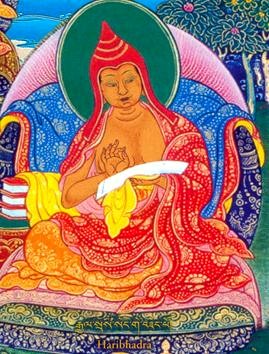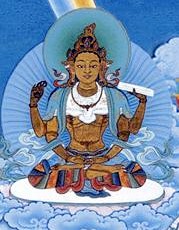Abhisamayalankara: Difference between revisions
Jump to navigation
Jump to search
m (→Outline) |
|||
| Line 7: | Line 7: | ||
#[[knowledge of all aspects]], omniscience (Skt. ''Sarvākārajñatā''; Tib. རྣམ་ཀུན་མཁྱེན་ཉིད་, ''nam kun khyen nyi'' or "namkhyen")<br> | #[[knowledge of all aspects]], omniscience (Skt. ''Sarvākārajñatā''; Tib. རྣམ་ཀུན་མཁྱེན་ཉིད་, ''nam kun khyen nyi'' or "namkhyen")<br> | ||
#[[path-knowledge]] (Skt. ''Mārgākārajñatā''; Tib. ལམ་ཤེས་ཉིད་, ''lamshe nyi'' or ''lamshe')<br> | #[[path-knowledge]] (Skt. ''Mārgākārajñatā''; Tib. ལམ་ཤེས་ཉིད་, ''lamshe nyi'' or ''lamshe'')<br> | ||
#[[base-knowledge]], knowledge of the bases, knowledge of the foundation (Skt. ''vastujñāna''; Tib. གཞི་ཤེས་,''zhishe'') but also all-knowledge (Skt. ''Sarvajñatā''; Tib. ཐམས་ཅད་ཤེས་པ་ཉིད་, ''tamche shepa nyi'')<br> | #[[base-knowledge]], knowledge of the bases, knowledge of the foundation (Skt. ''vastujñāna''; Tib. གཞི་ཤེས་,''zhishe'') but also all-knowledge (Skt. ''Sarvajñatā''; Tib. ཐམས་ཅད་ཤེས་པ་ཉིད་, ''tamche shepa nyi'')<br> | ||
#[[complete application of all aspects]], application of the realization of all aspects (Skt. ''Sarvākārābhisambodha''; Tib. རྣམ་ཀུན་མངོན་རྫོགས་རྟོགས་པ་ but also Tib. རྣམ་རྫོགས་སྦྱོར་བ་,''namdzog jorwa'')<br> | #[[complete application of all aspects]], application of the realization of all aspects (Skt. ''Sarvākārābhisambodha''; Tib. རྣམ་ཀུན་མངོན་རྫོགས་རྟོགས་པ་ but also Tib. རྣམ་རྫོགས་སྦྱོར་བ་,''namdzog jorwa'')<br> | ||
Revision as of 17:22, 14 January 2011

Abhisamayalankara (Skt. Abhisamayālaṃkāra; Tib. མངོན་རྟོགས་རྒྱན་, Ngöntok Gyen; Wyl. mngon rtogs rgyan), The Ornament of Clear Realization — one of the five treatises that were directly revealed to Asanga by the future Buddha Maitreya, it is a commentary on the hidden meaning of the Prajñaparamita Sutras, describing the entire journey of the bodhisattva, from the generation of bodhichitta to the attainment of full omniscience.
Outline

The text is divided into eight topics:
- knowledge of all aspects, omniscience (Skt. Sarvākārajñatā; Tib. རྣམ་ཀུན་མཁྱེན་ཉིད་, nam kun khyen nyi or "namkhyen")
- path-knowledge (Skt. Mārgākārajñatā; Tib. ལམ་ཤེས་ཉིད་, lamshe nyi or lamshe)
- base-knowledge, knowledge of the bases, knowledge of the foundation (Skt. vastujñāna; Tib. གཞི་ཤེས་,zhishe) but also all-knowledge (Skt. Sarvajñatā; Tib. ཐམས་ཅད་ཤེས་པ་ཉིད་, tamche shepa nyi)
- complete application of all aspects, application of the realization of all aspects (Skt. Sarvākārābhisambodha; Tib. རྣམ་ཀུན་མངོན་རྫོགས་རྟོགས་པ་ but also Tib. རྣམ་རྫོགས་སྦྱོར་བ་,namdzog jorwa)
- culminating application, application when reaching the peak (Skt. Murdhābhisamaya; Tib. རྩེ་མོར་སྦྱོར་བ་,tsemor jorwa)
- progressive application, gradual training, gradual application of the bodhisattva path (Skt. Anupurvābhisamaya; Tib. མཐར་གྱིས་པའི་སྦྱོར་བ་, thar gyi jorwa)
- instantaneous application, momentary training (Skt. Ekaksanābhisamaya; Tib. སྐད་ཅིག་མའི་སྦྱོར་བ་,kechigme jorwa)
- dharmakaya (Skt. dharmakāyabut also Dharmakāyābhisambodha; Wyl. chos sku; Tib. ཆོས་་སྐུ་, chö ku)
These eight topics are further divided into seventy points.
 བསྟན་བཅོས་བཞི་བརྒྱ་པ་ཞེས་བྱ་བའི་ཚིག་ལེའུར་བྱས་པ་, shes rab kyi pha rol tu phyin pa'i man ngag gi bstan bcos mngon par rtogs pa'i rgyan
བསྟན་བཅོས་བཞི་བརྒྱ་པ་ཞེས་བྱ་བའི་ཚིག་ལེའུར་བྱས་པ་, shes rab kyi pha rol tu phyin pa'i man ngag gi bstan bcos mngon par rtogs pa'i rgyan
Commentaries
Indian
- Arya Vimuktisena, Commentary on the Abhisamayalankara (Skt. abhisamayālaṅkārakārikāvārttika, Tib. ཉི་ཁྲི་སྣང་བ་, nyi khri snang ba)
 ཤེས་རབ་ཀྱི་ཕ་རོལ་ཏུ་ཕྱིན་པ་སྟོང་ཕྲག་ཉི་ཤུ་ལྔ་པའི་མན་ངག་གི་བསྟན་བཅོས་མངོན་པར་རྟོགས་པའི་རྒྱན་གྱི་ཚིག་ལེའུར་བྱས་པའི་རྣམ་པར་འགྲེལ་པ་, shes rab kyi pha rol tu phyin pa stong phrag nyi shu lnga pa'i man ngag gi bstan bcos mngon par rtogs pa'i rgyan gyi tshig le'ur byas pa'i rnam par 'grel pa
ཤེས་རབ་ཀྱི་ཕ་རོལ་ཏུ་ཕྱིན་པ་སྟོང་ཕྲག་ཉི་ཤུ་ལྔ་པའི་མན་ངག་གི་བསྟན་བཅོས་མངོན་པར་རྟོགས་པའི་རྒྱན་གྱི་ཚིག་ལེའུར་བྱས་པའི་རྣམ་པར་འགྲེལ་པ་, shes rab kyi pha rol tu phyin pa stong phrag nyi shu lnga pa'i man ngag gi bstan bcos mngon par rtogs pa'i rgyan gyi tshig le'ur byas pa'i rnam par 'grel pa
- Haribhadra, Sphutartha (Skt. Sphuṭārthā; Tib. འགྲེལ་པ་དོན་གསལ་, Wyl. 'grel pa don gsal)
Tibetan
| This section contains Tibetan script. Without proper Tibetan rendering support configured, you may see other symbols instead of Tibetan script. |
- Tsongkhapa, Golden Garland of Eloquence (ལེགས་བཤད་གསེར་ཕྲེང་, legs bshad gser phreng) (translated by Gareth Sparham, Jain Publishing, 2008)
 མངོན་རྟོགས་རྒྱན་འགྲེལ་ལེགས་བཤད་གསེར་འཕྲེང་ལས་རྣམ་པ་ཐམས་ཅད་མཁྱེན་པ་ཉིད་ཀྱི་སྐབས་, mngon rtogs rgyan 'grel legs bshad gser 'phreng las rnam pa thams cad mkhyen pa nyid kyi skabs
མངོན་རྟོགས་རྒྱན་འགྲེལ་ལེགས་བཤད་གསེར་འཕྲེང་ལས་རྣམ་པ་ཐམས་ཅད་མཁྱེན་པ་ཉིད་ཀྱི་སྐབས་, mngon rtogs rgyan 'grel legs bshad gser 'phreng las rnam pa thams cad mkhyen pa nyid kyi skabs
- Patrul Rinpoche, Overview
- Pöpa Tulku, The Oral Transmission of the Invincible Maitreya and An Adornment to the Vision of the Invincible Maitreya
 ཤེར་ཕྱིན་མངོན་པར་རྟོགས་པའི་རྒྱན་གྱི་ཚིག་དོན་རྣམ་པར་བཤད་པ་མ་ཕམ་ཞལ་ལུང་, sher phyin mngon par rtogs pa'i rgyan gyi tshig don rnam par bshad pa ma pham zhal lung
ཤེར་ཕྱིན་མངོན་པར་རྟོགས་པའི་རྒྱན་གྱི་ཚིག་དོན་རྣམ་པར་བཤད་པ་མ་ཕམ་ཞལ་ལུང་, sher phyin mngon par rtogs pa'i rgyan gyi tshig don rnam par bshad pa ma pham zhal lung ཤེར་ཕྱིན་གྱི་ཟིན་བྲིས་, sher phyin gyi zin bris
ཤེར་ཕྱིན་གྱི་ཟིན་བྲིས་, sher phyin gyi zin bris
- Amdo Geshe Jampal Rolwé Lodrö, The Essence of an Ocean of Fine Explanation
- Mipham Rinpoche ཤེར་ཕྱིན་མངོན་རྟོགས་རྒྱན་གྱི་མཆན་འགྲེལ་པུཎྜ་རི་ཀའི་དོ་ཤལ།, sher phyin mngon rtogs rgyan gyi mchan 'grel puN+Da ri ka'i do shal
 ཤེར་ཕྱིན་མངོན་རྟོགས་རྒྱན་གྱི་མཆན་འགྲེལ་པུཎྜ་རི་ཀའི་དོ་ཤལ།་, sher phyin mngon rtogs rgyan gyi mchan 'grel puN+Da ri ka'i do shal
ཤེར་ཕྱིན་མངོན་རྟོགས་རྒྱན་གྱི་མཆན་འགྲེལ་པུཎྜ་རི་ཀའི་དོ་ཤལ།་, sher phyin mngon rtogs rgyan gyi mchan 'grel puN+Da ri ka'i do shal
Translations
- Abhisamayalankara, Edward Conze (Rome: Is.M.E.O., 1954).
- Gone Beyond: The Prajnaparamita Sutras, The Ornament of Clear Realization, and Its Commentaries in the Tibetan Kagyu Tradition, Volume One, translated and introduced by Karl Brunnhölzl, Snow Lion, forthcoming 2011
- Ornament of Clear Realization: A Commentary on the Prajnaparamita of Maitreya, Thrangu Rinpoche, Zhyisil Chokyi Ghatsal, 2004.
- Abhisamayalankara (mngon rtogs rgyan), Maitreya – Asanga with commentary by Jamgön Mipham, Padmakara translation group, forthcoming
Further Reading
- John Makransky, Buddhahood embodied: sources of controversy in India and Tibet, New York: SUNY, 1997
